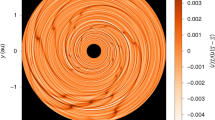Abstract
Planetesimals formed in the solar nebula by collisional coagulation. Dust aggregates settled toward the central plane, the larger ones growing by sweeping up smaller ones. A thin, dense layer of particles formed; shear-generated turbulence and differential motions induced by gas drag inhibited gravitational instability. Growth proceeded by collisions, producing planetesimals on a timescale of a few thousand years in the terrestrial zone. For bodies smaller than about a kilometer, motions were dominated by gas drag, and impact velocities decreased with size. At larger sizes gravitational interactions became significant, and velocities increased due to mutual perturbations. Larger bodies then grew more rapidly, this ``runaway'' led to formation of tens to hundreds of lunar- to Mars-sized planetary embryos in the zone of terrestrial planets. The final accretion of these bodies into a few planets involved large impacts, and occurred on a timescale of 107 to 108 years. This scenario gives a reasonably consistent picture of the origin of the terrestrial planets, but does not account for the anomalously low eccentricities of the Earth and Venus.
Similar content being viewed by others
References
Adachi, I., Hayashi, C., and Nakazawa, K.: 1976, 'The Gas Drag Effect on the Elliptical Motion of a Solid Body in the Primordial Solar Nebula', Prog. Theor. Phys. 56, 1756–1771.
Agnor, C., Canup, R., and Levison, H.: 1999, 'On the Character and Consequence of Large Impacts in the Late Stage of Terrestrial Planet Formation', Icarus 142, 219–232.
Benz, W., Slattery, W., and Cameron, A.G.W.: 1988, 'Collisional Stripping of Mercury's Mantle', Icarus 74, 516–528.
Blum, J., and Wurm, G.: 1999, 'Experiments on Sticking, Restructuring and Fragmentation of Preplanetary Dust Aggregates', Icarus 143, 138–146.
Chambers, J., Wetherill, G.W., and Boss, A.: 1996, 'The Stability of Multi-planet Systems', Icarus 119, 261–268.
Chambers, J., and Wetherill, G.W.: 1998, 'Making the Terrestrial Planets: N-body Integrations of Planetary Embryos in Three Dimensions', Icarus 136, 304–327.
Cuzzi, J.N., Dobrovolskis, A.R., and Champney, J. M.: 1993, 'Particle-gas Dynamics in the Midplane of the Solar Nebula' Icarus 106, 102–134.
Dominik, C., and Tielens, A.G.G.M.: 1997, 'The Physics of Dust Coagulation and the Structure of Dust Aggregates in Space', Astrophys. J. 480, 647–673.
Goldreich, P., and Ward, W.R.: 1973, 'The Formation of Planetesimals', Astrophys. J. 183, 1051–1061.
Greenberg, R., Wacker, J., Hartmann, W.K., and Chapman, C.R.: 1978, 'Planetesimals to Planets: Numerical Simulation of Collisional Evolution', Icarus 35, 1–26.
Ida, S., and Makino, J.: 1993, 'Scattering of Planetesimals by a Protoplanetary Slowing Down of Runaway Growth', Icarus 106, 210–227.
Ito, T., and Tanikawa, T.: 1999, 'Stability and Instability of the Terrestrial Protoplanet System and Their Possible Roles in the Final Stage of Planet Formation', Icarus 139, 336–349.
Kokubo, E., and Ida, S.: 1998, 'Oligarchic Growth of Protoplanets', Icarus 131, 171–178.
Lissauer, J., and Stewart, G.: 1993, 'Growth of Planets From Planetesimals', in D. Black and M. Matthews (eds.), Protostars and Planets III, Univ. Arizona Press, Tucson, pp. 1061–1088.
Safronov, V. S.: 1969, 'Evolution of the Protoplanetary Cloud and Formation of the Earth and Planets', Nauka, Moscow (in Russian; English translation NASA TTF-677, 1972).
Spaute, D., Weidenschilling, S. J., Davis, D.R., and Marzari, F.: 1991, 'Accretional Evolution of a Planetesimal Swarm: I. A New Simulation.', Icarus 92, 147–164.
Stepinski, T., and Valageas, P.: 1996, 'Global Evolution of Solid Matter in Turbulent Protoplanetary Disks. I. Aerodynamics of Solid Particles', Astron. Astrophys. 309, 301–312.
Stewart, G., and Wetherill, G.W.: 1988, 'Evolution of Planetesimal Velocities', Icarus 79, 542–553.
Stewart, G., and Ida, S.: 1999, 'Velocity Evolution of Planetesimals: Unified Analytical Formulae and Comparison With N-body Simulations', Icarus, submitted.
Weidenschilling, S. J.: 1977, 'Aerodynamics of Solid Bodies in the Solar Nebula', Mon. Not. R. Astron. Soc. 180, 57–70.
Weidenschilling, S. J.: 1980, 'Dust to Planetesimals: Settling and Coagulation in the Solar Nebula', Icarus 44, 172–189.
Weidenschilling, S. J.: 1984, 'Evolution of Grains in a Turbulent Solar Nebula', Icarus 60, 553–567.
Weidenschilling, S. J.: 1989, 'Stirring of a Planetesimal Swarm: The Role of Distant Encounters', Icarus 80, 179–188.
Weidenschilling, S. J.: 1995, 'Can Gravitational Instability Form Planetesimals?', Icarus 116, 433–435.
Weidenschilling, S. J.: 1997, 'The Origin of Comets in the Solar Nebula: A Unified Model', Icarus 127, 290–306.
Weidenschilling, S. J., and Cuzzi, J.N.: 1993, 'Formation of Planetesimals in the Solar Nebula', in E. Levy and J. Lunine (eds.), Protostars and Planets III, Univ. Arizona Press, Tucson, pp. 1031–1060.
Weidenschilling, S. J., Donn, B., and Meakin, P.: 1989, 'The Physics of Planetesimal Formation', in H. Weaver and L. Danly (eds.), The Formation and Evolution of Planetary Systems, Cambridge Univ. Press, pp. 131–150.
Weidenschilling, S. J., Spaute, D., Davis, D.R., Marzari, F., and Ohtsuki, K.: 1997, 'Accretional Evolution of a Planetesimal Swarm 2. The Terrestrial Zone', Icarus 128, 429–455.
Wetherill, G.W., and Stewart, G.: 1989, 'Accumulation of a Swarm of Small Planetesimals', Icarus 77, 330–357.
Wetherill, G.W., and Stewart, G.: 1993, 'Formation of Planetary Embryos: Effects of Fragmentation, Low Relative Velocity, and Independent Variation of Eccentricity and Inclination', Icarus 106, 190–209.
Wetherill, G.W., and Inaba, S.: 2000, 'Planetary Accumulation With a Continuous Supply of Planetesimals', this volume.
Whipple, F.L.: 1972, 'On Certain Aerodynamic Processes for Asteroids and Comets', in A. Elvius (ed.), From Plasma to Planet, Wiley, New York, pp. 211–232.
Yoshinaga, K., Kokubo, E., and Makino, J.: 1999, 'The Stability of Protoplanetary Systems', Icarus 139, 328–335.
Author information
Authors and Affiliations
Rights and permissions
About this article
Cite this article
Weidenschilling, S.J. Formation of Planetesimals and Accretion of the Terrestrial Planets. Space Science Reviews 92, 295–310 (2000). https://doi.org/10.1023/A:1005259615299
Issue Date:
DOI: https://doi.org/10.1023/A:1005259615299




